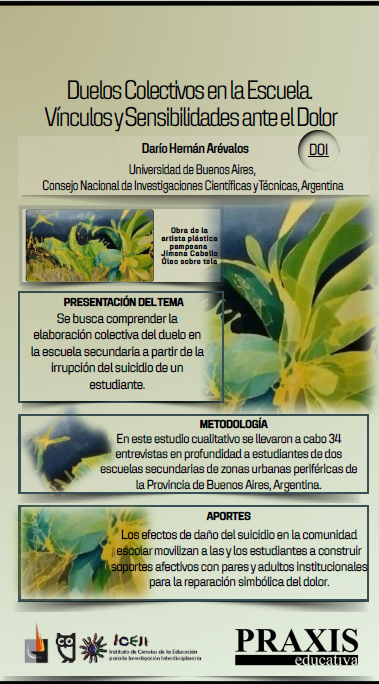Collective Grief at School. Bonds and Sensitivities to Pain
DOI:
https://doi.org/10.19137/praxiseducativa-2025-290210Keywords:
suicide, grief, affective support, young students, secondary schoolAbstract
This article aims to understand the collective elaboration of grief in the school environment based on the suicide of a student. The results of a qualitative study carried out in two secondary schools in peripheral urban areas of the Province of Buenos Aires, Argentina, are presented. The analysis of the testimonies allows us to affirm that when faced with the death of a generational peer, the school enables processes of symbolic reparation by favouring a) the constitution of networks of affective support; b) the learning of sensitivity towards the pain of others. The bonds of solidarity and mutual support in the school network, in a context of individualisation of social life, make it possible to reduce the affective distances between the mourners and to constitute collective narratives of meaning.
Downloads
References
Alexander, J. (2016). Trauma cultural, moralidad y solidaridad La construcción social del Holocausto y otros asesinatos en masa. Revista Mexicana de Ciencias Políticas y Sociales, 61(228), 191-210. https://www.scielo.org.mx/scielo.php?pid=S0185-19182016000300191&script=sci_abstract
Arévalos, D. H. (2020). Emotividades sobre la muerte en el ámbito escolar. Un estudio socioeducativo sobre los sentidos que construyen jóvenes estudiantes de zonas urbanas periféricas [Tesis de doctorado]. Universidad de Buenos Aires.
Arévalos, D.H. y Kaplan, C.V. (2022). Experiencias de soledad en la socialización escolar. Educación, Lenguaje y Sociedad, 20 (20), 1-18. http://dx.doi.org/10.19137/els-2022-202002
Elías, N. (1989). La soledad de los moribundos. Fondo de Cultura Económica.
Elías, N. (1994). Civilización y Violencia. REIS, 65, 141-152. https://reis.cis.es/index.php/reis/article/view/1694
Fondo de las Naciones Unidas para la Infancia. (2019). El suicidio en la adolescencia. Situación en la Argentina. Unicef. https://www.unicef.org/argentina/media/6326/file/Suicidio_adolescencia.pdf
García, P. D., Kaplan, C. V. y Szapu, E. (2023). Comunicación de las emociones y tramitación del dolor social en la escuela: un estudio socioeducativo con jóvenes estudiantes de la provincia de Buenos Aires. Revista Teias, 24(75), 320-335. https://doi.org/10.12957/teias.2023.76950
Glaser, B. y Strauss, A. (1967). The Discovery of Grounded Theory: Strategies for Qualitative Research. Aldine Publishing Company.
Kaplan, C. V. (2021). La implicación afectiva en tiempos de pandemia y postpandemia. Educar para una sociedad de reciprocidades. Revista Anales de la Educación Común, 1(1-2), 104-113. https://ri.conicet.gov.ar/bitstream/handle/11336/166405/CONICET_Digital_Nro.afcec780-7b12-4847-b007-5c4a2eaf8f6a_B.pdf?sequence=2&isAllowed=y
Kaplan, C. V. (2022). La afectividad en la escuela. Paidós.
Kaplan, C.V. y Arévalos, D.H. (2021). La necesidad de soporte afectivo en jóvenes del sistema educativo. Revista de Educación, 12 (22), 193-208. https://fh.mdp.edu.ar/revistas/index.php/r_educ/article/view/4802/5000
Kaplan, C. V. y García, P. D. (2023). Investigar las emociones en el campo educativo: aportes metodológicos de la aplicación de una encuesta a estudiantes del nivel secundario. Revista Latinoamericana de Metodología de las Ciencias Sociales, 13(2), e131. https://doi.org/10.24215/18537863e131
Márquez, I. (2017). Muerte 2.0. Pensar e imaginar la muerte en la era digital. Andamios. Revista de Investigación Social, 33(14). https://www.scielo.org.mx/scielo.php?script=sci_arttext&pid=S1870-00632017000100103
Organización Mundial de la Salud. (2 de septiembre de 2019). Suicide worldwide in 2019. https://www.who.int/publications/i/item/9789240026643
Piovani, J. (2018). Otras formas de análisis. En M. Marradi, N. Archenti y J. Piovani (Coords.), Manual de Metodología de las Ciencias Sociales (pp. 287-296). Siglo XXI.
Sampieri, R., Fernández Collado, C. y Baptista Lucio, M. (2014). Metodología de la investigación. McGraw-Hill.
Walter, T. (1994). The Revival of Death [El renacimiento de la muerte]. Routledge.
Walter, T. (1999). On Bereavement: The Culture of Grief [Sobre el duelo: La cultura del duelo]. Open University Press.
Walter, T., Hourizi, R., Moncur, W. y Pitsillides, S. (2012). Does the Internet Change How We Die and Mourn? [¿Internet cambia la forma en que morimos y lloramos? Resumen y análisis]. OMEGA. 64(4), 275-302. https://doi.org/10.2190/OM.64.4.a
Wouters, C. (2002). The Quest for New Rituals in Dying and Mourning: Changes in the We–I Balance [La búsqueda de nuevos rituales en la muerte y el duelo: cambios en el equilibrio entre nosotros y yo]. Body and Society, 8(1). 1-27. https://doi.org/10.1177/1357034X02008001001
Zabludovsky Kuper, G. (2020). Lenguaje y emociones ocultas: testimonios de violencia y trauma. En M. Ariza (Coord.), Las emociones en la vida social. Miradas sociológicas (pp. 149-178). UNAM.

Published
Issue
Section
License
Copyright (c) 2025 Darío Hernán Arevalos

This work is licensed under a Creative Commons Attribution-NonCommercial-ShareAlike 4.0 International License.
Copyright Notice
Editorial Committee Educational Praxis Magazine:
I hereby declare that I am the author of the article titled (article name), that it is original and my own and that it was not previously published in any other format or medium. I declare to know that the magazine will not charge me any type of fee under any circumstances, nor will I receive any type of monetary compensation If it were accepted for publication in Educational Praxis, I authorize the aforementioned magazine to publish it digitally and to advertise it on its social networks.
If the work is published, I adhere to the Creative Commons license called "Attribution - Non-Commercial Share Alike CC BY-NC-SA", through which it is allowed to copy, reproduce, distribute, publicly communicate the work and generate derivative works, as long as when the original author is cited and acknowledged. This license has been used since September 2018. In 2016 CC BY NC ND 4.0 was adhered to; and in the years 2017 and 2018 (January-August) CC BY NC 4.0.
This CC BY-NC-SA Share Alike license does not, however, permit commercial use of the work. As an author, the journal may establish additional agreements for the non-exclusive distribution of the version of the work published in the journal, it allows me to self-archive the published articles, in their post-print version, in institutional, thematic repositories, personal web pages or any other relevant use. with the recognition of having been first published in this journal.
Educational Praxis adheres to DORA (Declaration on Research Assessment) signed in San Francisco, California, on December 16, 2012, and to the Declaration of Mexico (Joint Declaration LATINDEX - REDALYC - CLACSO - IBICT).














_(1)2.png)


3.png)











_(2).png)






2.jpg)









